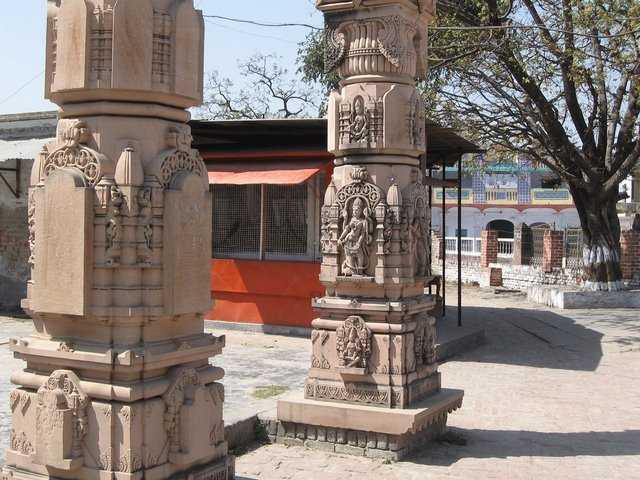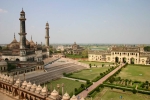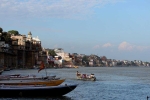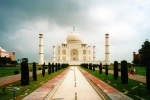"The birthplace of Lord Rama"
Ayodhya Tourism
Assumed to be the birthplace of Lord Rama, Ayodahya has been surrounded by controversy since about a decade now but yet, has so much colour and spirituality to see for its tourists taking form of various attractions here including Ram janmabhoomi and various other temples.
Located on the banks of river Sarayu, Ayodhya is a city inUttar Pradeshwith rich history and numerous legends. Former capital of Awadh, Ayodhya plays a critical role in the Hindu epic of Ramayana. According to the epic, Ayodhya is believed to be the birthplace of Lord Rama. Given its association with Hinduism, it is predominantly a religious tourist destination with all its temples and historical significance. Most recently, Ayodhya has been in news for the Babri Mosque dispute. The mosque, which was allegedly built on Ram Janmabhoomi temple, became the bone of contention between Hindus and Muslims. In 2005, Ayodhya witnessed a terrorist attack at the site of Ramlalla temple.
Download Ayodhya PDF Guide >
What's Great?
Ayodhya is famous as a holy tourist spot as it has many pilgrim sites and temples. The place is known for its purity and simplicity.
What's not so Great?
The place is meant for a religious tour and not a relaxing vacation. It can be hot and dry a major part of the year.
For Whom
Ayodhya is meant for elderly people. This place is for people who are intending to go on a religious trip and not a vacation
History of Ayodhya
Ayodhya is best known for being the city of Hindu mythological epic Ramayana. As per Legends, Saint Manu, the initiator of mankind founded the city and gave it to the Ikshvaku clan to rule. Being the capital city of Kosala, Ayodhya was then ruled by King Dasaratha, a descendant of Ikshvaku. It is, however interesting to note that historians have interpreted Ayodhya's existence, as per Ramayana, as an urban centre consisting of buildings and palaces. But, the excavations at present-day Ayodhya indicate that it had a primitive life. This has led to the conclusion that the city of Ayodhya in Ramayana was a fictional one. A local tradition states that Ayodhya became desolate after Lord Rama's ascent to heaven and was later revived by a King Vikramaditya of Ujjain, in 50 BCE. The great Kalidasa, however, mentions in Raghuvamsa that Lord Rama?s son Kusa was the one who led Ayodhya?s revival. Several legends like Brahmanda Purana and Garuda Purana mention Ayodhya as one of the "most sacred and foremost cities" and "one of the holiest places for Hindus in India", respectively. The Jain tradition states that 5 Tirthankaras- Rishabhanatha (first), Ajitanatha (second), Abhinandananatha (fourth), Sumatinatha (fifth) and Anantanatha (fourteenth) were born in Ayodhya.
Dispute of Ramjanmabhoomi Temple
The biggest centre of attraction of Ayodhya is Ram Janmabhoomi Temple. It is believed to be the birthplace of 7th incarnation of Lord Vishnu, Lord Ram. Although this area is under dispute. It is believed that there was a temple here which was demolished by Mughal Emperor Babur in 1528 AD and built a mosque over there. The mosque was again demolished in 1922 and since then the land is under dispute.
Itinerary
Day 1 -Start by visiting Ram Janmabhoomi Temple and feel the legend. Then you can visit Moti Mahal and admire the beautiful architecture of this temple.Day 2-You can visit Hanuman Garhi, Treta Ke thakur, Kanak Bhawan and Gupatr Ghat.
Restaurants and Local Food in Ayodhya
Options for food in the area can be quite limited since the food is only vegetarian and there aren't many fancy dining places in the small town. The handful of local restaurants and Dhabas here offer Punjabi, North-Indian and Chinese cuisines. The state is known for the color and flavors of its Chaat, which includesAloo Tikki, Pani Puri, Kachori, Papri Chaat, Samosaand more.
View 2 Restaurants in Ayodhya >>
Oct-Maris the best time to visit Ayodhya
Weather is mostly pleasant in Ayodhya, all throughout the year. There are occasional heat waves and cold breeze during the peak of summer and winter seasons. The best time to visit although is between October to December, both for its weather and the festivities.
Weather in Ayodhya
Loading...
Ayodhya in Summer (April - June)
Summers are from April to June in Ayodhya. The temperature remains in between 28 degree Celsius to 45 degrees Celsius. The high temperatures makes it an unsuitable weather for sightseeing.
Ayodhya in Monsoon (July - September)
Monsoon is from July to September. During this time, the temperature ranges from 24 degrees Celsius to 32 degrees Celsius. It is advisable to avoid visiting Ayodhya during the monsoons as the heavy rains might disrupt your plans for sightseeing.
Ayodhya in Winter (October - March)
Winters are from October to March in Ayodhya. The temperature ranges in between 5 degrees Celsius to 27 degrees Celsius. This is the best time for visiting the place.
Monthly Weather in Ayodhya
Month
Avg. Minimum (°C)
Avg. Maximum (°C)
January
8
22
February
11
27
March
16
33
April
23
40
May
25
41
June
27
41
July
27
34
August
27
34
September
26
34
October
21
33
November
14
29
December
10
22
Comments on Ayodhya
Post Your Comment


 Ramjanma Bhoomi
Ramjanma Bhoomi Kanak Bhawan
Kanak Bhawan Hanuman Garhi
Hanuman Garhi Nageshwarnath Temple
Nageshwarnath Temple Lucknow
Lucknow Varanasi
Varanasi Allahabad
Allahabad Agra
Agra Khajuraho
Khajuraho Nainital
Nainital